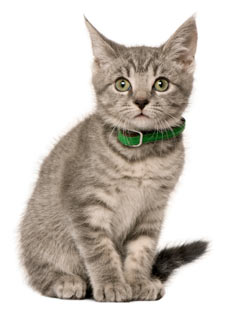Worms in Cats: Feline Intestinal Parasites

The digestive tract of cats can host a number of parasites. Some of these are zoonotic, which means that people can contract them from their cat, especially people who are immune compromised. This includes the elderly, the young, and those with immune-mediated illnesses or who are on chemotherapy. It is important to know about these parasites and the risks they may pose to your cat and your family.
Parasitic infections are very common in cats. Bring a sample of stool (also called feces or bowel movement) when you visit the veterinarian so that the staff can identify parasites lurking in your cat's gastrointestinal tract. This is important because not all parasites are visible to the naked eye but need to be viewed through a microscope.
Note that successful treatment generally requires multiple doses of a dewormer. This is because many deworming medications only clear parasites that are at a certain point in their lifecycle. Other stages of the lifecycle remain, and those need to be cleared out with another dose of dewormer when they reach the stage that is affected by it. Because of this, follow-up stool checks will need to be done to confirm that the infestation has been cleared.
All kittens need a series of professionally prescribed deworming treatments, even if their stool sample results are negative. This is because there are not always parasite eggs present in every bit of stool. Kittens are so commonly affected by parasites that they should be given general deworming medications even if the stool check does not identify them.
The most common intestinal parasites (commonly called worms) found in cats are discussed below.
Cat Roundworms
Also called ascarids, these are very common parasites of cats, especially kittens.
The feline roundworms are Toxocara cati and Toxascaris leonina. These parasites are contracted by walking through eggs in the soil and grooming them off the fur or skin, nursing from an infected mother cat, or eating a rodent that is infected by roundworms.
Kittens infested with roundworms usually look normal, but they may have stunted growth and a poor hair coat. In young cats, heavy infestation with roundworms can lead to a tender abdomen, poor appetite, weakness, and diarrhea. Adult worms can sometimes be seen in the stool or, more rarely, in vomit. A very heavy worm burden may even cause intestinal blockage in a small kitten.
People can become infected with feline roundworms by ingesting eggs that are in the soil. The eggs hatch into larvae that migrate through body tissues and can lead to severe organ problems or blindness. Known as visceral larva migrans, this occurs most often in children, who may play in sand or dirt, then put their hands in their mouths or eat something without washing first.
Sand boxes are a prime culprit for children becoming infected by Toxocara cati because they are attractive places for cats to defecate, leaving roundworm eggs behind.
Unfortunately, once the rain falls and the sand gets stirred up, a watchful parent will not be aware of the potential dangers lurking in these play areas. Three important ways to help your child avoid being infected by feline roundworms are:
- Having your child wash her hands after playing and before putting her hands in her mouth or eating anything.
- Ensuring that any sand boxes your child plays in are covered at night to keep outdoor cats from using them as large litter boxes.
- Making sure that any cats that live with you are routinely dewormed, have fecal samples checked as often as your veterinarian recommends, and that you keep litter boxes secured out of reach of your child.
Cat Hookworms
These parasites (Ancylostoma spp) live in a cat's small intestine. Hookworms are blood-sucking parasites; infestation can lead to anemia, diarrhea, and inflammation of the small intestine. Hookworm infestation is especially harmful in young or debilitated kittens. Transmission occurs either through skin penetration by larvae or by eating an infected rodent or cockroach. When skin penetration occurs, it can leave skin irritation and sores.
Common clinical signs in cats infected with hookworms include diarrhea, which may be dark or tarry in appearance, decreased appetite, and general un-thriftiness. The diagnosis of hookworms is based on history, physical examination, and a fecal flotation test.
Hookworms are also zoonotic, and can infect humans when the larvae penetrate their skin, resulting in a condition called cutaneous larval migrans. It causes severely itchy skin lesions. People may rarely develop a gastrointestinal hookworm infection if they ingest soil contaminated with hookworm eggs, usually by eating poorly-washed vegetables.
Cat Tapeworms
Cestodes, or tapeworms, are common in the United States. The two most common types of tapeworm of cats are Taenia and Dipylidium. Each species has a different route of transmission—through eating infected rodents, and ingesting infected fleas respectively.
Signs of tapeworm infestation include tapeworm segments that generally look like grains of rice in the stool or at the back end in the fur and "scooting" along the ground due to irritation of the rectum. Sometimes segments may be found crawling across the floor or dried up on surfaces. Definitive diagnosis is made by observing adult segments or through microscopic identification of eggs in the feces. One must prevent fleas and mouse-hunting in order to avoid tapeworm infestations.
Other Cat Parasites
Stomach worms, lungworms, heartworms, worm larvae under the skin (cuterebra), and fluke worms can also infect cats. Other parasite eggs may be swallowed during hunting and can be found in the feces but do not necessarily undergo a presence and life cycle in the cat. Single-celled parasitic organisms such as giardia, coccidia, and toxoplasma also infect cats routinely. The important thing to know is that diagnosis of parasitic worms and other parasites in cats at home is only rarely possible, and if you see tapeworm segments or roundworms, usually this indicates the presence of a heavy worm burden. Take a fresh stool sample in to be checked at the interval recommended by your local veterinarian to help keep these nasty parasites under control!
You May Also Like These Articles:
Pet Insurance: Peace of Mind for Your Cat's Health
Notice: Ask-a-Vet is an affiliated service for those who wish to speak with a veterinary professional about their pet's specific condition. Initially, a bot will ask questions to determine the general nature of your concern. Then, you will be transferred to a human. There is a charge for the service if you choose to connect to a veterinarian. Ask-a-Vet is not manned by the staff or owners of CatHealth.com, and the advice given should not delay or replace a visit to your veterinarian.






